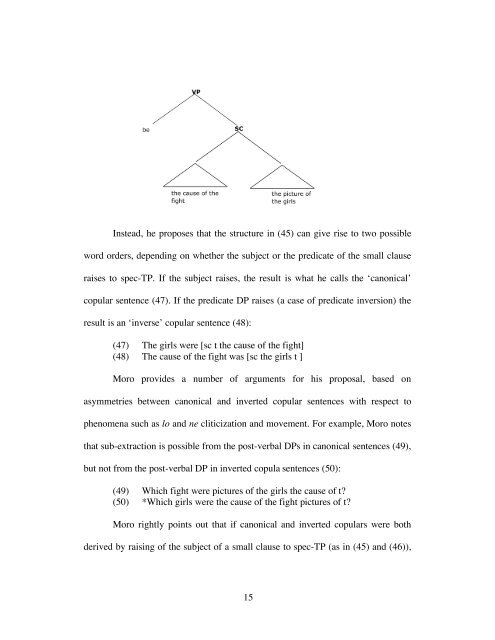Post Verbal Subjects and Agreement in Brazilian Portuguese
Post Verbal Subjects and Agreement in Brazilian Portuguese
Post Verbal Subjects and Agreement in Brazilian Portuguese
You also want an ePaper? Increase the reach of your titles
YUMPU automatically turns print PDFs into web optimized ePapers that Google loves.
Instead, he proposes that the structure <strong>in</strong> (45) can give rise to two possible<br />
word orders, depend<strong>in</strong>g on whether the subject or the predicate of the small clause<br />
raises to spec-TP. If the subject raises, the result is what he calls the ‘canonical’<br />
copular sentence (47). If the predicate DP raises (a case of predicate <strong>in</strong>version) the<br />
result is an ‘<strong>in</strong>verse’ copular sentence (48):<br />
(47) The girls were [sc t the cause of the fight]<br />
(48) The cause of the fight was [sc the girls t ]<br />
Moro provides a number of arguments for his proposal, based on<br />
asymmetries between canonical <strong>and</strong> <strong>in</strong>verted copular sentences with respect to<br />
phenomena such as lo <strong>and</strong> ne cliticization <strong>and</strong> movement. For example, Moro notes<br />
that sub-extraction is possible from the post-verbal DPs <strong>in</strong> canonical sentences (49),<br />
but not from the post-verbal DP <strong>in</strong> <strong>in</strong>verted copula sentences (50):<br />
(49) Which fight were pictures of the girls the cause of t?<br />
(50) *Which girls were the cause of the fight pictures of t?<br />
Moro rightly po<strong>in</strong>ts out that if canonical <strong>and</strong> <strong>in</strong>verted copulars were both<br />
derived by rais<strong>in</strong>g of the subject of a small clause to spec-TP (as <strong>in</strong> (45) <strong>and</strong> (46)),<br />
15

















